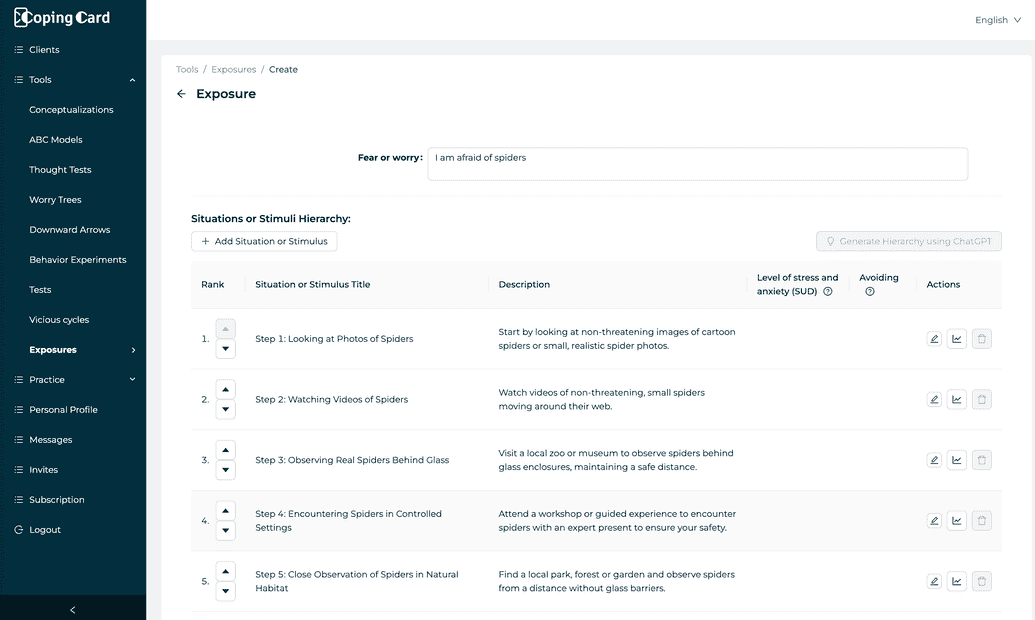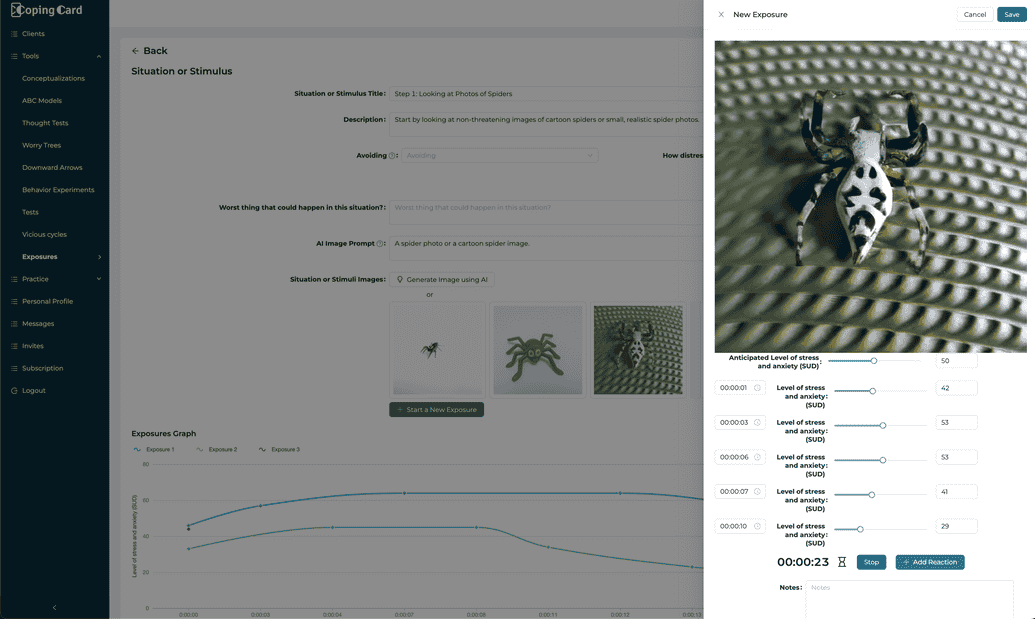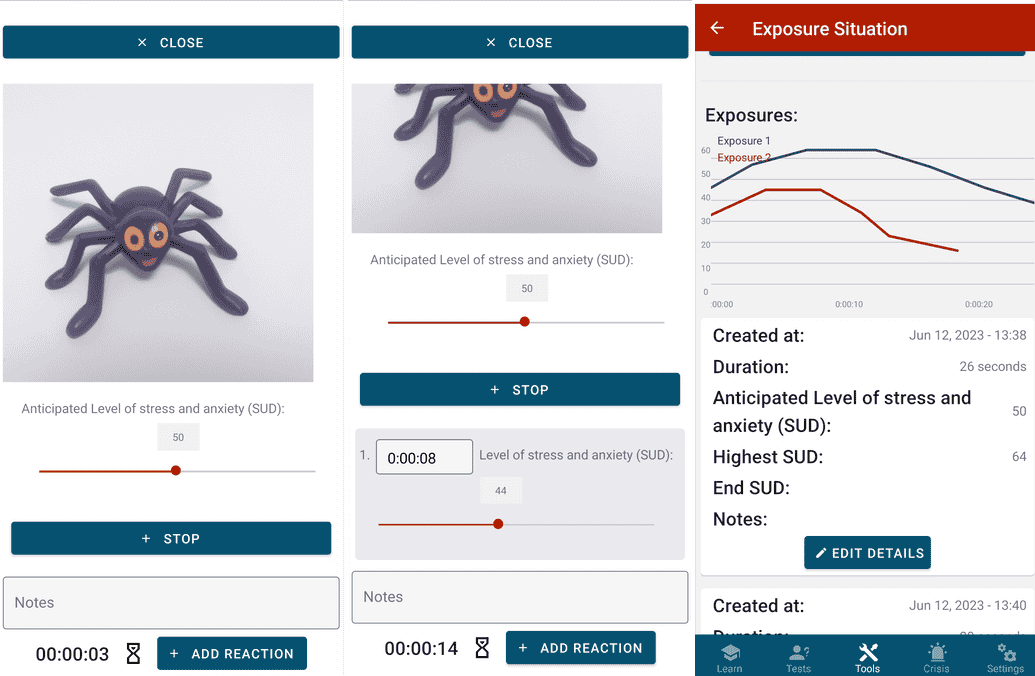Articles
General
Practice Management
Research Summaries
CBT Techniques: Exposure
Exposure therapy is an empirically validated technique used to treat anxiety, phobia, panic, PTSD, social anxiety and other disorders. Anxiety disorders are known to be supported in part by the client avoiding frightening external or internal stimuli. The therapist's task in exposure is to help the client systematically overcome his or her fears by repeatedly encountering frightening objects, actions, situations, thoughts, or feelings.
By encouraging clients to face their fears, we break the pattern of avoidant behavior and fear reactions. Exposure leads to an outcome in which the brain adapts to new information, showing that frightening consequences are unlikely and stress is quite tolerable. Exposure therapy helps combat cognitive distortions such as overestimation of probability and catastrophization. The effectiveness of exposure therapy for anxiety and related disorders is evidenced by many clinical studies.
There are 4 types of exposure exercises:
In vivo exposures;
Imaginative exposures;
Exposures for thoughts;
Exposures to bodily sensations (interoceptive).
Surprisingly, a working method such as exposure, with its solid empirical and theoretical basis for anxiety disorders, is not often used by therapists. In most cases this is because the therapists fear upsetting the client or destroying the therapeutic relationship with the client at all. This decision is often associated with myths about exposure therapy (e.g., that exposures can increase anxiety, that they are unsafe to use until the client has mastered certain coping strategies, etc.). This can lead the therapist to engage in sub-therapeutic (not enough to elicit a therapeutic response) treatment, and such therapy is not effective for the client. It is important to help the client understand that hundred percent safety is an irrational goal, and that a willingness to endure certain threats and risks is an essential part of a happy life.
General Exposure Technique Instructions
- Identify the fear or anxiety: Begin by working with your therapist to identify the specific fear or anxiety you wish to address. This could be a fear of public speaking, social situations, specific animals, or even specific thoughts.
- Create a fear hierarchy: Develop a list of situations, objects, or thoughts related to your fear, ordered from least anxiety-provoking to most anxiety-provoking. This hierarchy will serve as a roadmap for your graduated exposure exercises. Make sure to include several steps in the hierarchy to ensure a gradual progression.
- Learn relaxation techniques: Before starting exposure exercises, it's essential to learn and practice relaxation techniques, such as deep breathing, progressive muscle relaxation, or mindfulness meditation. These techniques can help you manage anxiety during the exposure process.
- Start with the least anxiety-provoking situation: Begin by confronting the least anxiety-provoking item on your fear hierarchy. This could involve imagining the situation, looking at a picture of the feared object, or physically visiting a location where the fear is present, depending on the nature of your anxiety.
- Practice exposure exercises regularly: Graduated Exposures requires consistent practice to be effective. Schedule regular exposure sessions, ideally multiple times per week (or even per day). Consistency is key to reducing anxiety over time.
- Rate your anxiety levels: During each exposure exercise, rate your anxiety level on a scale of 0-100, with 0 being no anxiety and 100 being extreme anxiety. This will help you track your progress and determine when to move on to the next step in your fear hierarchy.
- Move up the hierarchy: As your anxiety decreases for each situation or object, move on to the next item in your fear hierarchy. Continue to practice exposure exercises at each level until you can comfortably face the most anxiety-provoking situation.
- Patience and perseverance: Overcoming fears and anxieties using Graduated Exposures can take time. Be patient with yourself and remember that progress may be slow but steady. Celebrate small victories and continue working through your fear hierarchy until you've successfully faced and conquered your fear.
- Maintain progress: After successfully completing your fear hierarchy, it's important to maintain your progress by occasionally revisiting the situations or objects that once caused anxiety. This will help prevent the return of fears and reinforce your newfound confidence.
Remember that working with a therapist is recommended when using the Graduated Exposures technique, as they can provide guidance, support, and expertise throughout the process. With persistence and determination, you can overcome your fears and improve your overall well-being using the Graduated Exposures technique in CBT.
Exposure Technique in CopingCard Mobile app and Provider Platform
This short video shows a quick overview of how you can use the powerful Exposure technique both in our Provider Platform and the Mobile app.
And here is a more detailed explanation:
- Our Mobile App offers clients the ability to create Exposures and come up with hierarchies of situations that provoke anxiety/phobia. Our Provider Platform allows therapists to create the exposures and hierarchies for clients to educate them on how to use the technique during the session and to collaborate more effectively. To help make it faster and more efficient the Provider version offers the ability to generate the hierarchy with the use of Generative AI.
- Both the Mobile app and the Provider Platform make it easy to add details for each situation/stimulus, as well as offer the ability to use Generative AI to come up with images that might help at some steps of the hierarchy, when the exposures are imaginative or viewing pictures.
- Our CBT Mobile App and Provider Platform make it easy to monitor reactions during exposures and automatically generate graphs to visualize progress.
Overall our Platform and Mobile app and the power of AI make the process of coming up with, engaging the client and therapeutic monitoring of the progress substantially more efficient, making it easier to use the Exposure technique that has enough evidence to be a core component for treating many mental-health related disorders.
Relevant research studies:
Here are some well-known research studies and reviews highlighting the effectiveness and superiority of exposure therapy for various conditions:
Foa, E. B., & Kozak, M. J. (1986). Emotional processing of fear: Exposure to corrective information. Psychological Bulletin, 99(1), 20-35. In this seminal paper, Foa and Kozak propose the Emotional Processing Theory, which serves as the basis for exposure therapy. The authors suggest that exposure to fear-evoking stimuli allows for the processing and integration of corrective information, leading to a reduction in fear and anxiety. Link: https://doi.org/10.1037/0033-2909.99.1.20
Öst, L. G. (1989). One-session treatment for specific phobias. Behaviour Research and Therapy, 27(1), 1-7. This study by Öst demonstrated the effectiveness of a single session of exposure therapy in treating specific phobias. Participants experienced significant reductions in fear and avoidance after just one session, with improvements maintained at follow-up assessments. Link: https://doi.org/10.1016/0005-7967(89)90113-7
Foa, E. B., Hembree, E. A., & Rothbaum, B. O. (2007). Prolonged exposure therapy for PTSD: Emotional processing of traumatic experiences, therapist guide. Oxford University Press. Foa, Hembree, and Rothbaum's guide on Prolonged Exposure Therapy for PTSD is based on extensive research demonstrating the superiority of exposure therapy for individuals with post-traumatic stress disorder. The guide provides detailed instructions for therapists on how to implement this evidence-based treatment. Link: https://doi.org/10.1093/med:psych/9780195308501.001.0001
Powers, M. B., Sigmarsson, S. R., & Emmelkamp, P. M. G. (2008). A meta-analytic review of psychological treatments for social anxiety disorder. International Journal of Cognitive Therapy, 1(2), 94-113. In this meta-analysis, Powers, Sigmarsson, and Emmelkamp reviewed the effectiveness of various psychological treatments for social anxiety disorder. The results showed that exposure therapy, particularly when combined with cognitive restructuring, was among the most effective interventions for reducing social anxiety symptoms. Link: https://psycnet.apa.org/record/2009-03653-002
Norton, P. J., & Price, E. C. (2007). A meta-analytic review of adult cognitive-behavioral treatment outcome across the anxiety disorders. The Journal of Nervous and Mental Disease, 195(6), 521-531. This meta-analysis by Norton and Price examined the effectiveness of cognitive-behavioral treatments, including exposure therapy, for various anxiety disorders in adults. The results demonstrated the superior effectiveness of exposure-based treatments across multiple anxiety disorders, including panic disorder, generalized anxiety disorder, and obsessive-compulsive disorder. Link: https://doi.org/10.1097/01.nmd.0000253843.70149.9a
These studies and reviews provide strong evidence for the effectiveness and superiority of exposure therapy in treating a range of anxiety-related conditions, such as specific phobias, PTSD, social anxiety disorder, and other anxiety disorders.
Other sources:
Kristen S. Springer, David F. Tolin - The Big Book of Exposure



